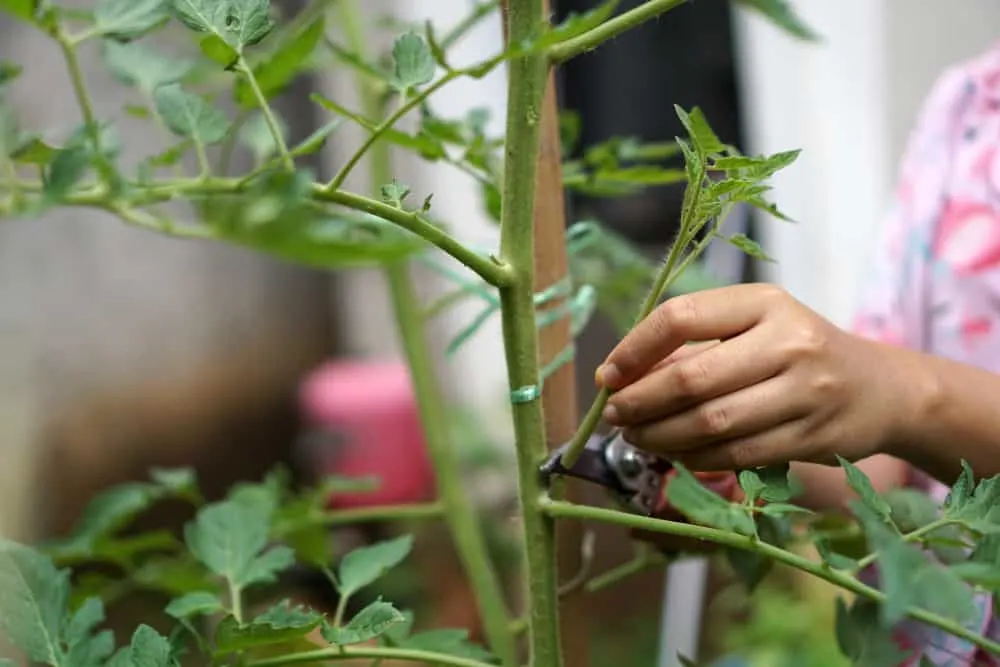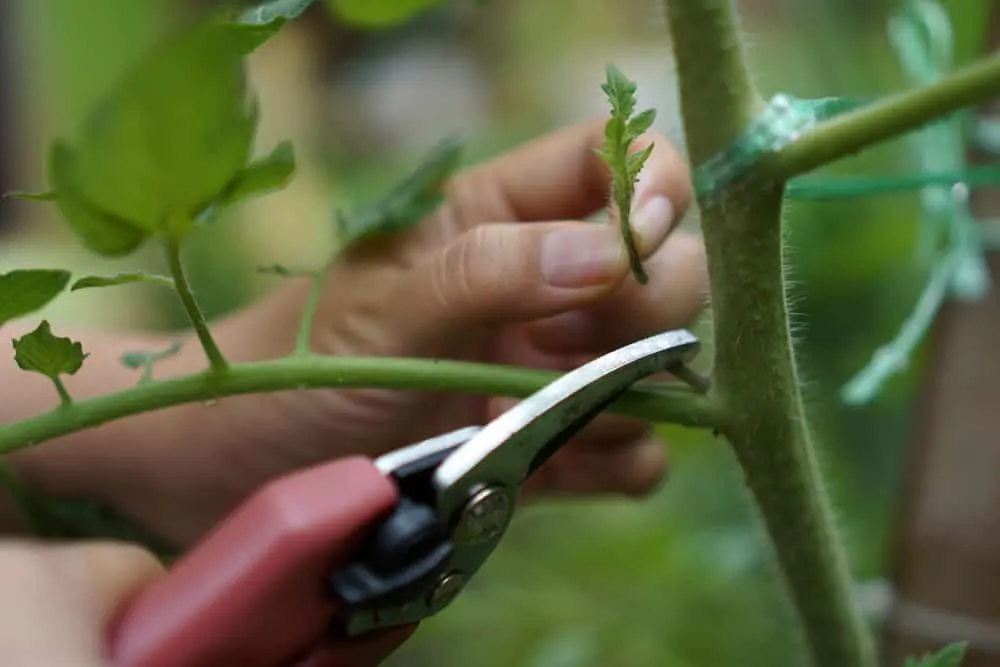
Tomatoes are one of the most popular vegetables to grow, if not THE most popular. And yes, I know they’re technically a fruit, but I’m a vehement ‘tomatoes are vegetables’ person.
They’re simple plants to grow and care for, with only a few special care considerations for a bountiful harvest.
Growing tomatoes from seeds is a simple task. You can even grow full tomato plants from whole tomato slices.

But if you don’t have the patience to wait for seeds to sprout, or you have a friend with a tomato variety you’d like to try, the quickest and most reliable way to propagate is from cuttings.
Tomato cuttings can be transplanted in just over a week and grow rapidly into strong, fruit-producing plants. The stems have adventitious roots (small roots along all parts of the stem) that allow them to establish quickly. You’ll be on your way to having delicious tomatoes in no time.
How To Remove Cuttings From The Plants
Tomatoes produce suckers – the side shoots that sprout just where a branch meets the main stem (the axil). These suckers eventually grow, becoming branches with their own leaves and fruit.
Related Reading: Tomato Suckers: What Should You Really Do With Them?
They’re the reason why tomato plants are bushy and sprawling. They’re also the reason why propagating tomatoes is so easy.
If you’re a fan of pruning tomatoes, you will be removing these suckers as part of your maintenance routine anyway. Instead of throwing these cuttings on the compost pile, you can use them to make more plants. This is best done as early in the season as possible, to give your new plant the chance to grow and produce fruit before the first frost comes.

For fast growth, remove suckers from a rapidly maturing variety. Indeterminate tomatoes have a slightly higher chance of success than determinate ones, but your cutting is likely to develop quick roots either way.
Your chosen sucker needs to be no more than 6-inches long and have a minimum of two leaves. The plant needs leaves for photosynthesis, and while the cutting will eventually develop more leaves, they need to start out with some for a boost of energy.
Gently snip them off with clean, sharp garden shears. It’s best to remove your tomato cuttings, or any cuttings, at a 45⁰ angle to maximize surface area. Alternatively, you can cut the stems off at the base and then remove a small section to get the right angle.
How to Root a Tomato Cutting
Water

The easiest rooting option, and the one you see often all over social media, is rooting in water.
This popular propagation method for indoor plants works just as well for tomatoes.
Simply place your sucker in a glass or container of room temperature water. Make sure no leaves are submerged and that only the bottom part of your cutting is in the water.
Place your cutting in a warm spot in indirect sunlight.

Keep a watchful eye on the water levels, topping up when necessary. Change the water every few days to keep it fresh, or change more often if it looks dirty.
It usually takes between 10 and 14 days for your tomato sucker’s roots to start developing. Leave the cutting in the glass for a little longer to let the roots lengthen for a strong start. Once they are about an inch long, they are ready to be transplanted out into the garden.
Soil

While it looks like a fun experiment, you don’t have to root your tomatoes in water. You can go straight ahead and root them in soil.

Tomatoes rooted in water take some time to adjust to the conditions of soil, so rooting this way provides the least risk and likely the strongest plants.
You may not be able to check the growth under the soil line as you can in a glass, but a small tug on the cutting will tell you whether the roots have developed or not.
For the best results, plant your suckers in small containers in an airy medium like coco peat or compost and water well.
Once your tomato cuttings have developed a healthy root ball, you can transplant them in your garden, or even bigger containers. This usually takes about a week or two.
Transplanting The Cuttings

To transplant your cuttings, gently remove them from their container of water or soil and plant them in your garden as you would any other plant.
Remember, your tomato plants need the right spot in the garden, with the right spacing to thrive.
Whether they’re planted in raised beds, containers, or traditional rows, your tomatoes need space and a nice sunny spot.
Tomatoes should be planted deeply, with soil covering 2/3rds of the plant. As a rule of thumb, tomato plants should be no less than 2 feet apart.
Your tomato cuttings will soon grow to full-sized plants, producing their own juicy tomatoes.
Propagating tomatoes from cuttings is easy and simple. It’s a great way to clone your favorite tomato variety.
You can even propagate smaller varieties and grow your tomatoes indoors throughout winter. As long as they’re getting plenty of sunlight and water, you could be enjoying homegrown tomatoes all year round.
The major benefit of propagating from cuttings is that you could be enjoying your new tomato plant in just over a month. As long as you’ve watered and fed your correctly planted tomatoes, they’ll reward you with an impressive harvest.
